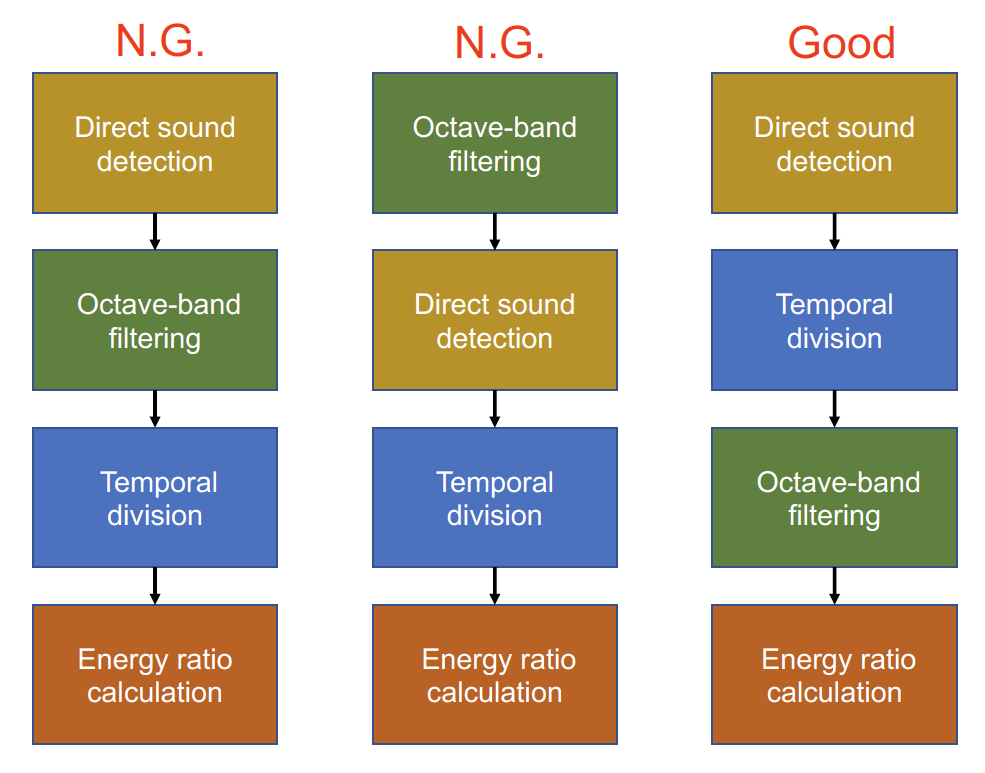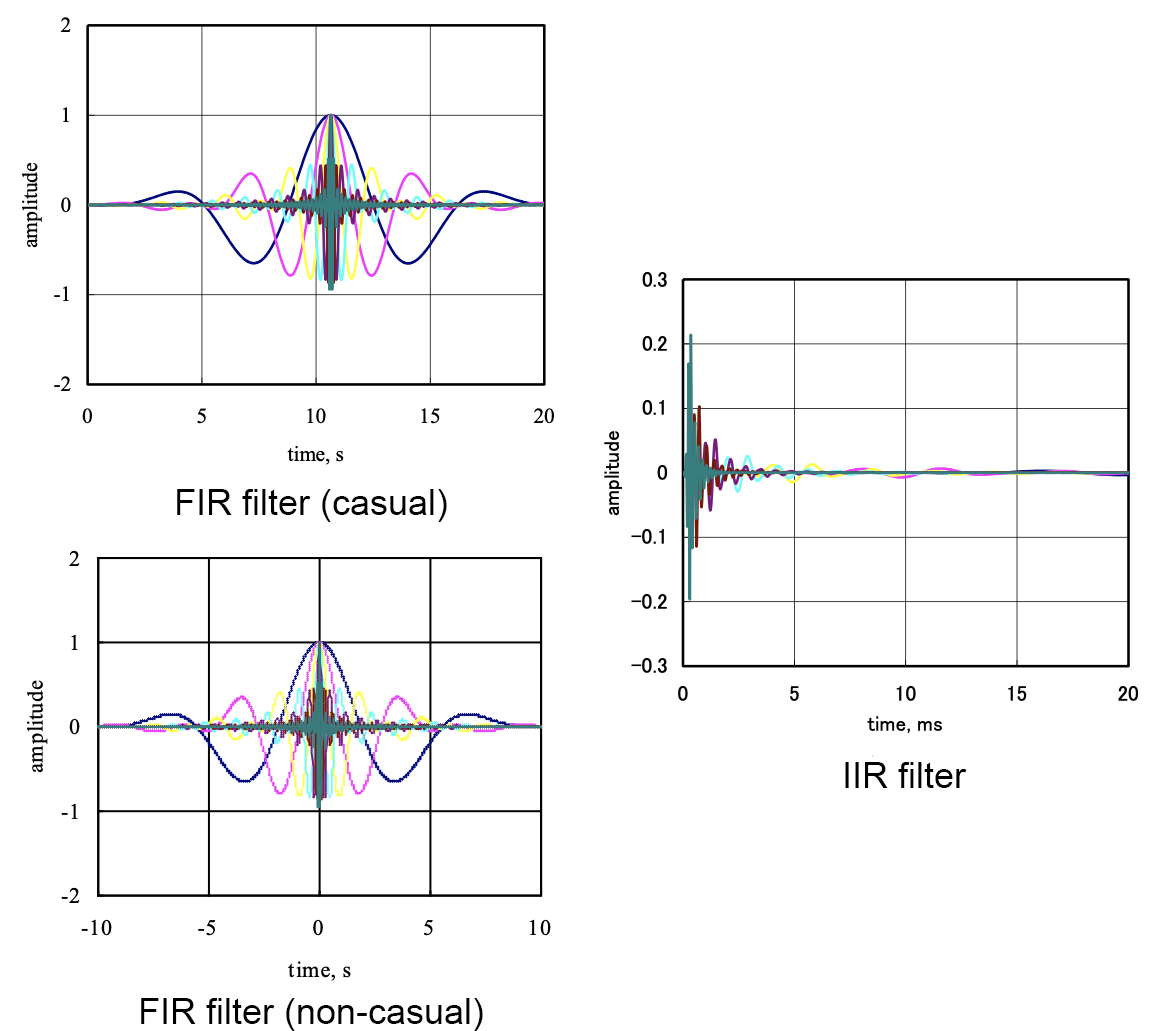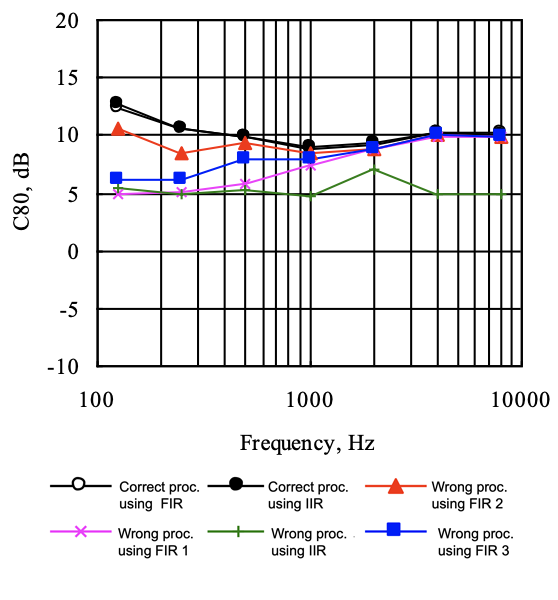Benchmark Problems for Acoustical Parameters
Column 4:
Filtering first? Time Division first?
–The procedure to derive energy ratio of time division and band analysis–
The definition of C-value and D-value
There are some points to be aware of with calculation for C-value (early-to-late index) and D-value (definition or deutlichkeit), which are ratios of energy separated by time. We would like to introduce the definition of C80 (Clarity) and D50. A procedure to calculate C80 is defined as an energy ratio between the first 80ms component (early-arriving sound energy) and the latter component (late-arriving sound energy), where octave filtering processing for each component is done after the time division (see formula (1)). Higher value of C80 denotes that more early-arriving energy is coming to the receiving point. A procedure to calculate D50 is defined as an energy ratio between the first 50ms component and total sound energy. Higher value of D50 denotes that more energy within 50 ms after arriving direct sound is coming to the receiving point (see formula (2)). Both indexes are deriving energy of early reflections. \begin{align} C_{80} =10\log_{10} \left( \frac{\int_{0_\textrm{ms}}^{80_\textrm{ms}}p^2(t)\textrm{d}t}{\int_{80_\textrm{ms}}^{\infty}p^2(t)\textrm{d}t} \right) \\ D_{50} =\frac{\int_{0_\textrm{ms}}^{50_\textrm{ms}}p^2(t)\textrm{d}t}{\int_{0_\textrm{ms}}^{\infty}p^2(t)\textrm{d}t} \end{align}What is the problem?
The definitions of both indexes are quite obvious. Then, what is the problem? The essence of the problem is these indexes are derived in each octave band. In “ISO 3382-1”, the procedure of processing impulse responses is described that they should be filtered into octave bands from 125 Hz to 4 kHz (“Impulse responses should be filtered into octave bands.”).Pure tone (sine wave) has a concentrated energy in one frequency value. But the waveform of response will temporally spread due to the time response of the filter, if the impulse response is filtered in octave band. Furthermore, depending on the type of filter, a time delay of response might occur.
Therefore, if the impulse response is divided into early- and late-components with time window after the octave filtering procedure, the energy of the early part would extend or shift to the latter part in time domain because of the filtering.
To avoid this problem, ISO 3382-1 notifies that “the best approach for avoiding the filter delay problems is to time-window the broadband impulse response before any filtering.” When determining the arrival time of the direct sound (0 ms), it is also necessary to consider the start of the direct sound. The direct sound should be determined from the broadband impulse response as the first point of apparent rise from background noise, more than 20 dB below the maximum. ("The start of the impulse response … should be determined from the broadband impulse response, where the signal first rises significantly above the background but is more than 20 dB below the maximum.")
These are based on the idea that "the energy of response should be divided before the time domain signal of response spreads or moves, in other words, so that the identification of the filter type or direct sound position does not affect the results of the calculation".
Fig. 1 shows the possible flow of calculation procedures. As shown in the figure, the "direct sound position detection" and the "time window division" must be processed before the "filtering". Here, we prepared three types of filters: two types of FIR filters (causal and non-causal) and one type of IIR filter. The filter waveforms are shown in Fig. 3.

Figure 1: All the possible procedures to calculate C80.
Difference of calculated value of index depending on the procedure of calculation
The impulse response of reverberation time of 0.5 seconds shown in Fig. 2 is a response with a large reflection slightly before 80 ms. For this response, the value of C80 is calculated utilizing six different calculation procedures and filter types, as shown in Table 1.
Figure 2: The impulse response for comparison test. It has a large reflection energy at just before 80 ms.
Table 1: Calculation procedures for comparison test. These are combined with three different (1st - 3rd) procedures and three filters (FIR(casual, non-casual) and IIR).
| Name | Procedure | Note | |||
| 1st | 2nd | 3rd | 4th | ||
| Correct /w FIR | Direct sound detection | Temporal division | Octave-band filtering with FIR | Energy ratio calculation | Correct procedure complying with ISO3382-1 |
| Correct /w IIR | Octave-band filtering with IIR | ||||
| Wrong /w FIR-1 | Octave-band filtering with FIR (non-casual) | Temporal division | Wrong procedure | ||
| Wrong /w IIR | Octave-band filtering with IIR | ||||
| Wrong /w FIR-2 | Octave-band filtering with FIR (casual) | ||||
| Wrong /w FIR-3 | Octave-band filtering | Direct sound detection | |||

Figure 3: The waveforms of three different filters.

Figure 4: The C80 calcuation results for comparison. Two black lines represent the results of correct procedure.